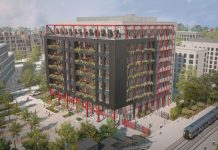Following the introduction of social distancing measures to stop the spread of coronavirus, the RICS Q1 2020 UK Construction and Infrastructure Market Survey results are unsurprisingly consistent with a sharp deterioration in momentum across the South West.
The net balance for workloads for all sectors is at its lowest level for the first time in seven years, with -1% more respondents reporting a fall in activity. Due to the UK lockdown, regional market confidence has fallen sharply, and the majority of contributors now envisage a fall in workloads, new hiring and profit margins in the coming year.
Prior to the stricter lockdown measures – when survey responses are analysed by date of submission and pre-26 March, responses were still indicating a broadly resilient picture for the sector. After this date, responses unsurprisingly signalled a sharp downturn in workloads.
Looking at the sectors within the South West, activity fell sharply across both the private and public housing sectors. The survey also highlights a drop in workloads for new commercial developments with the private industrial sector stagnating. Infrastructure workloads did grow in first quarter of 2020, with +29% more respondents reporting an increase, up from +9% in Q4 2019. Other public works workloads also rose in Q1, but at a much slower rate than in previous quarters, with +11% (down from +19%) more respondents in the South West reporting a growth.
Over the past three months, the number of new business enquiries for construction in the South West fell, with -2% more respondents reporting a fall. Over the same period however, +21% more respondents saw a rise in the number of firms taking on new employees, albeit it this has slipped from a net balance of +38% in the last quarter of 2019.
Respondents anticipate a drop in output over the coming year, with headline workload expectations for the next twelve months dropping to -13% in Q1 from a net balance of +53% in Q4.
Breaking down the sectors, respondents are more optimistic for future workloads in the infrastructure and other public works sector. +35% more respondents in the South West, expect growth in workloads in infrastructure in the next twelve months, up from +29% in Q4 2019. In other public works, +17% more respondents expect a growth in workloads, up from +14% in Q4 2019.
Assessing the future of the South West’s construction sector, the RICS market confidence indicator, a composite measure of workloads, employment and profit margins expectations over the coming twelve months, fell sharply to -31% from +31% in Q4. Within this, profit margins were anticipated to see sharpest fall in the coming year with 64% more surveyors anticipating a fall. Moreover, tender price expectations have eased significantly over the quarter in both the building and civil engineering components.
Simon Rubinsohn, RICS Chief Economist comments:
“It is hardly a surprise that sentiment in the construction sector fell particularly sharply following the imposition of the lockdown. More ominously, the forward looking metrics have also softened materially, suggesting that it will not simply be a case of returning to where the industry was prior to the onset of Covid-19 as the government begins to ease the lockdown. Partly this reflects uncertainty about the likely state of the economy at this point and how this will impact on development, but it is also indicative of the challenge the sector is currently under as it attempts to access government funding to keep heads above water.”
Hew Edgar, Head of Government Relations, added:
“The supporting measures that the Government introduced in the immediacy for the built environment – covering pay, rent, and business operating costs to name a few – were welcome, but it has become apparent that there are gaps that need addressing; not least parity in approach across the UK.
“The UK Government must start exploring how the sector could taper the reopening of non-essential construction sites within stringent parameters of health and safety adherence; introduce grants; and review how repair and maintenance work could proceed whilst public buildings are not fully occupied. A combination of these will support professionals, the workforce, manufacturers and supply chains by providing a pipeline of work and vital cash flow in the short term.
“Fiscal stimulus is most effective once the construction starts on site; only then does finance start to flow down the supply chain. As such, the Government should explore how best to accelerate and enable the design, planning approval, and procurement of construction projects to ensure construction-ready schemes can start when the pandemic subsides.”



















